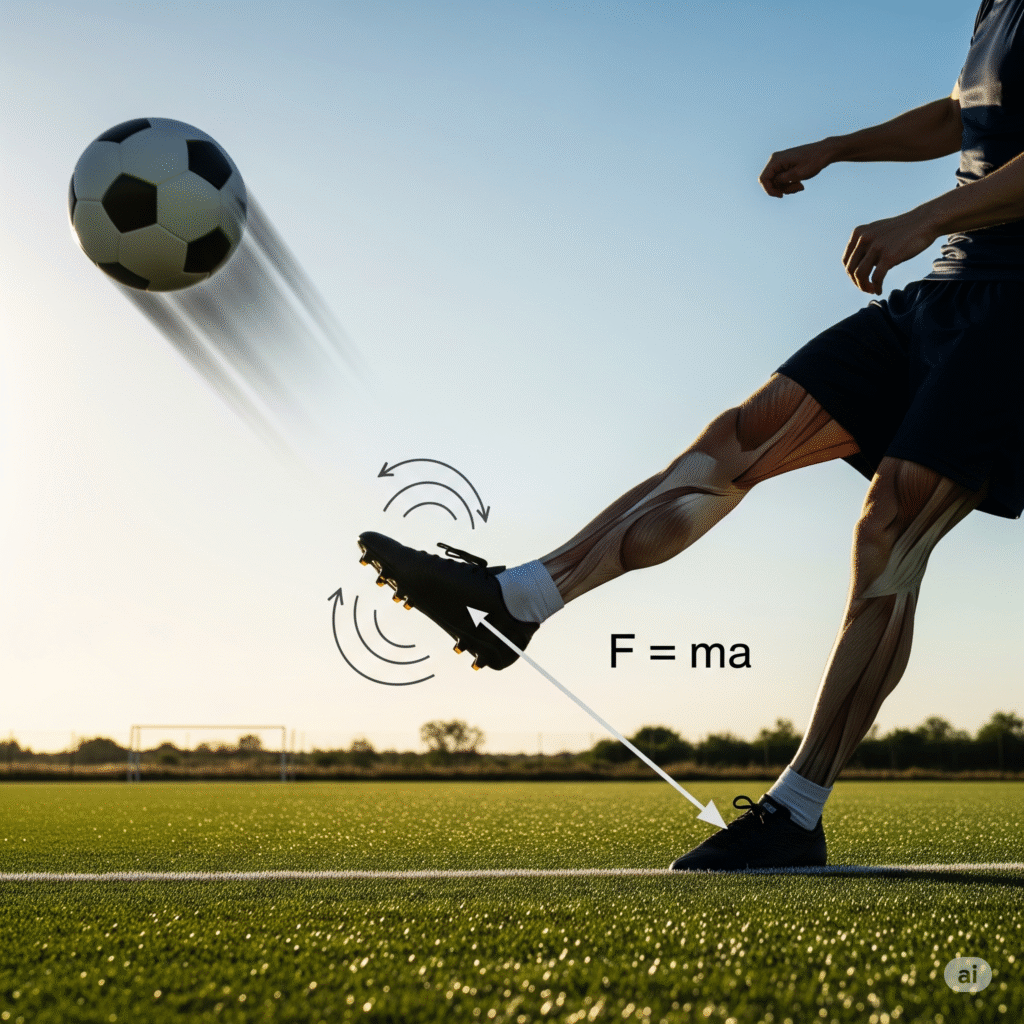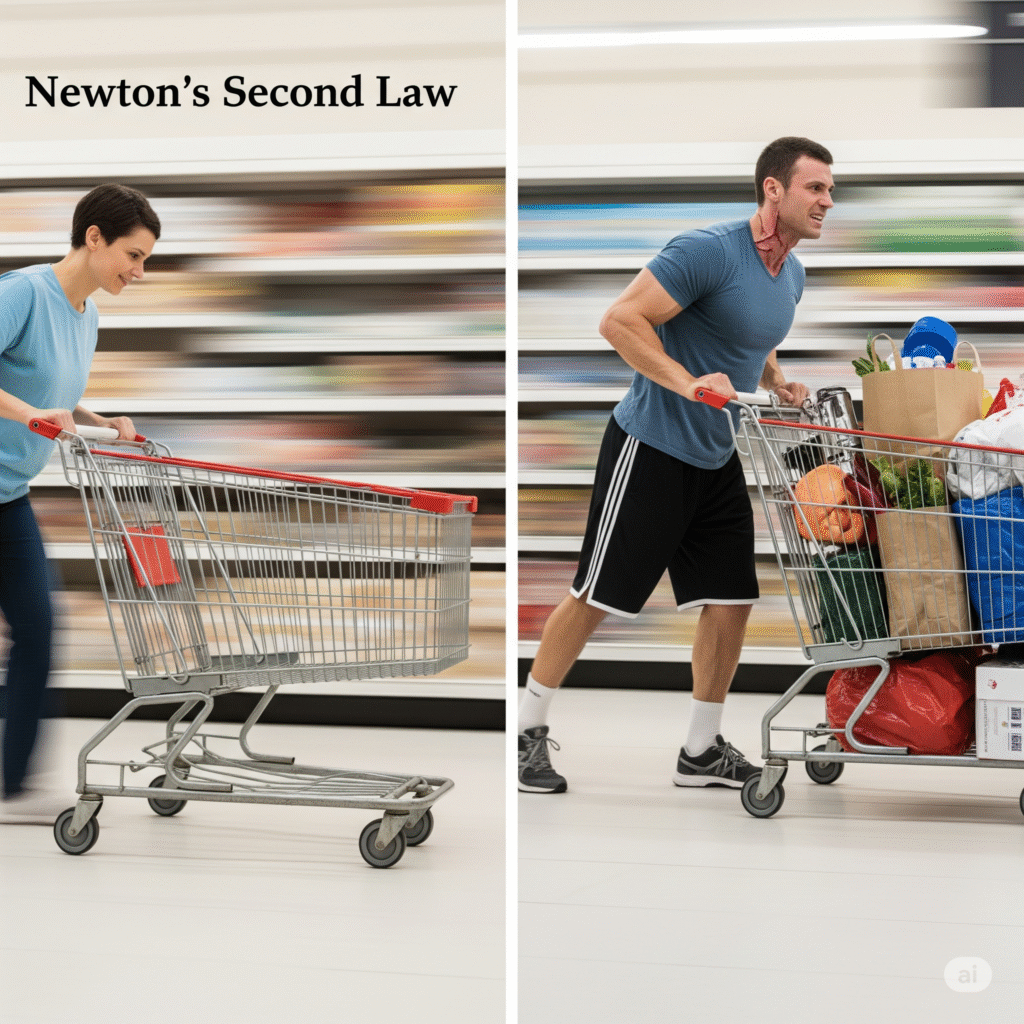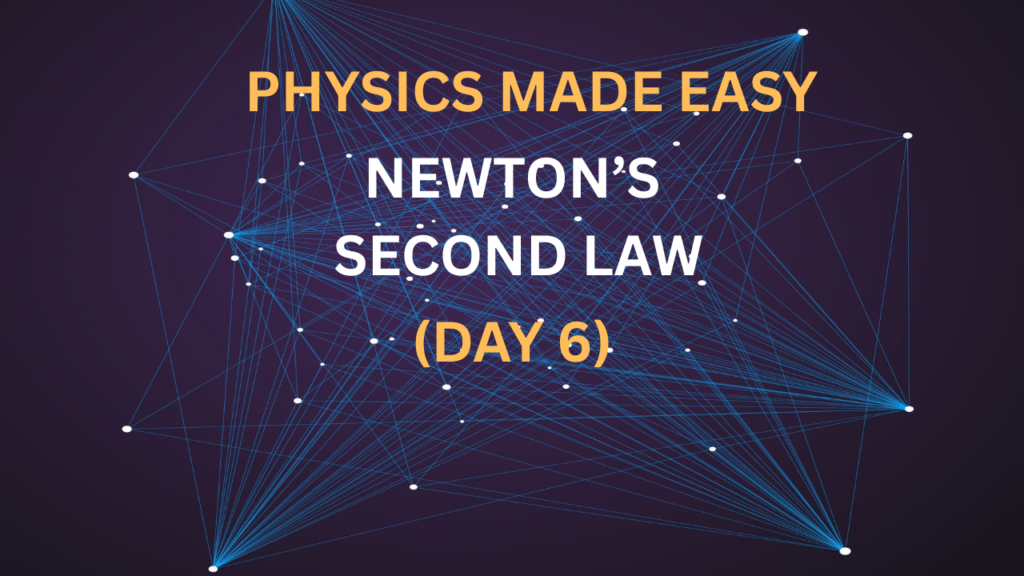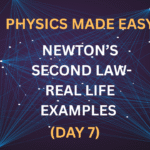Introduction
Newton’s Second Law of Motion is one of the most fundamental concepts in physics.Have you ever wondered why it’s easier to push an empty shopping cart than one loaded with groceries? Or why you can kick a football farther with a strong kick? The answer lies in Newton’s Second Law of Motion, one of the most fundamental concepts in physics. This article, part of our Physics Made Easy series and building on the principles of Newton’s First Law,will explore Newton’s Second Law of Motion, its practical examples, real-world connections, and what it really tells us about how the world around us moves.
What is Newton’s Second Law of Motion?
Newton’s Second Law of Motion explains how an object’s acceleration depends on its mass and the force applied to it. Simply put:
- The harder you push something, the faster it accelerates.
- The heavier an object, the more force you need to move it (or accelerate it).
That’s why it’s easier to push a light bicycle up a hill than a heavy motorcycle. Understanding Newton’s Second Law of Motion is at the heart of mechanics, engineering, and even sports!

The Famous Formula: F=ma
Newton summarized this law with one of the most famous formulas in physics:
F=m×a
Where:
- F = Force (measured in Newtons, N)
- m = Mass (measured in kilograms, kg)
- a = Acceleration (measured in meters per second squared, m/s²)
This powerful equation, the core of Newton’s Second Law of Motion, tells us that:
- ✅ Force is directly proportional to both mass and acceleration.
- ✅ If you increase the mass of an object, you’ll need more force to give it the same acceleration.
- ✅ If you increase the force applied to an object, it will accelerate faster (assuming mass stays constant).
Applying Newton’s Second Law of Motion with Easy Examples



Newton’s Second Law of Motion is evident in many everyday scenarios:
- 🛒 Pushing a Shopping Cart Imagine pushing two shopping carts:
- An empty cart moves easily because its mass is small (mdownarrow, so Fdownarrow for same a).
- A full cart requires much more force to achieve the same acceleration because its mass is larger (muparrow, so Fuparrow for same a).
- ⚽ Kicking a Football If you want to send the ball flying:
- A strong kick applies greater force, creating more acceleration (Fuparrow, so auparrow for same m).
- A light tap means less force and minimal acceleration.
- 🚴♀️ Riding a Bicycle When cycling:
- Pedaling harder means you exert more force, leading to more acceleration and a higher speed.
- Carrying a heavy backpack increases the total mass of the system. To achieve the same acceleration, you’ll need to apply more force.
Real-World Connections: The Power of Newton’s Second Law
Newton’s Second Law of Motion is all around us. Every movement and design process relies on this law to ensure safety, efficiency, and performance across various fields:
- Automotive Engineering: Designing engines, braking systems, and overall vehicle dynamics depends critically on understanding force, mass, and acceleration. Electric car companies like Tesla meticulously calculate these factors to optimize speed, acceleration, and safety explore Tesla’s vehicle design principles.
- Rocket Science: When rockets launch, they burn fuel to produce immense amounts of thrust (force) that must overcome their substantial mass to achieve incredible acceleration. Organizations like NASA and SpaceX use this law to plan every part of their missions, from liftoff trajectories to orbital maneuvers learn about rocket propulsion from NASA.
- Sports Training: Athletes train to exert greater force to run faster, jump higher, or hit balls with more power. This is why strength training is a core part of sports science; it directly increases the force an athlete can generate, leading to better performance in accordance with F=ma.
- Industrial Machines: Machines in factories, from robotic arms to conveyor belts, are designed to move heavy parts using precisely calculated forces. This understanding allows automation to work reliably and efficiently, ensuring materials are moved and processes are completed with the right acceleration.
Why Does This Matter to Us?
Newton’s Second Law of Motion simplifies the way we understand how motion changes. It’s the key to:
- Creating faster cars and airplanes.
- Improving athletic performance.
- Reducing injuries by understanding the forces involved in safety systems.
- Designing everyday tools—from cranes to bicycles—to function optimally.
If you look closely, almost every movement around you where an object changes its speed or direction is governed by Newton’s Second Law of Motion!
Quick Recap Table
| Key Element | Meaning |
| Force (F) | A push or pull measured in Newtons (N) |
| Mass (m) | Quantity of matter in an object, in kg |
| Acceleration (a) | Change in speed over time, in m/s² |
| Formula | F=mtimesa |
Summary
Newton’s Second Law of Motion is far more than an equation—it’s the secret to understanding why and how things move and interact. From pushing a shopping cart to launching rockets into space, it fundamentally shapes our world. Remember:
- Greater force = greater acceleration (for a given mass).
- Greater mass = more force needed (for a given acceleration).
By grasping this law, you’ll see physics at work in every dynamic movement around you.
What Do You Think?
Can you think of another example of Newton’s Second Law of Motion in your daily life? Share your observations or questions in the comments below!.



